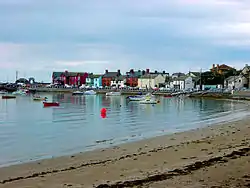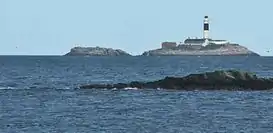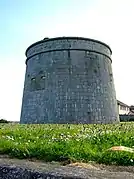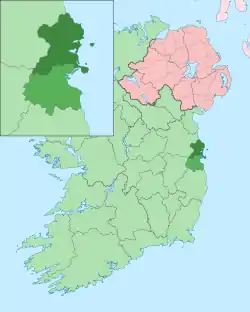Skerries, Dublin
Skerries (Irish: Na Sceirí, meaning "Rocky Islands") is a coastal town in Fingal, Ireland. Historically Skerries was a fishing port and later a centre of hand embroidery. These industries declined in the early 20th century, however, and it became both a resort town and a commuter town for Dublin.
Skerries
Na Sceirí | |
|---|---|
Town | |
 Brightly painted houses at Skerries harbour | |
 Skerries Location in Ireland | |
| Coordinates: 53.5828°N 6.1083°W | |
| Country | Ireland |
| Province | Leinster |
| County | Fingal |
| Council | Fingal |
| Elevation | 5 m (16 ft) |
| Population (2016)[1] | |
| • Urban | 10,043 |
| Time zone | UTC±0 (WET) |
| • Summer (DST) | UTC+1 (IST) |
| Eircode routing key | K34 |
| Telephone area code | +353(0)1 |
| Irish Grid Reference | O248606 |
Geography
Skerries is on gently sloping land approaching the coast, which is partly overlooked by low bluffs. There are hills around, including Mill Hill, where a windmill has long been sited. The town has five islands off its coast called Shenick Island, St Patrick's, Colt and the island formation of Rockabill, which comprises "The Cow" and "The Calf",[2] separated by a narrow channel. There is also Red Island, which is a tied island.
The town itself is built around three long streets - Strand Street, Church Street and Balbriggan Road, and between the surrounding hills and beaches. Skerries South Strand is a long sandy beach (2.5 km long). Red Island, Mill Hill, Hillside, the nearby Ardgillan Park and Demesne, Barnageeragh and to a lesser extent Baldungan Castle, provide vantages overlooking the town.
Rockabill has the largest numbers of breeding roseate terns in Europe. It is also the farthest set of islands from the town and has a lighthouse which is 4 miles from the nearest path on the mainland at Red Island. The Martello tower on Shenick Island is one of a number of defensive towers erected during the Napoleonic era along the Irish coast by the British. The tower is situated 1 mile from the great windmill and a similar distance from both the Monument on Strand Street and the other Martello tower on Red Island. This forms an almost perfect arc through the major tall secular structures in the town with the Martello tower on Shenick at the centre. Shenick Island is accessible on foot at the lowest tides, but potentially problematic, due to turning tides. The other islands are harder to reach, but it is possible by boat. St Patrick's Island is so-called because this Saint Patrick is reputed to have landed on the island.
History
Etymology
The name comes from the Norse words skere and "ey" which has been rendered in the Irish language na sceirí which means rocky islands.
Invasions and saints
Early writers tell how an island off Skerries was used as a landing place for an invasion, which happened in the second century C.E. This island was either Shenick or Red Island, which would have been a tidal island at the time. When the invaders landed, they formed ranks and at low tide marched to the mainland, where they were promptly defeated at the ancient settlement of Knocknagin, north of Balbriggan. The islands were previously known as the Islands of Cor possibly after the original inhabitants.

As noted, in 432 AD, St. Patrick landed on Church Island, and according to the Annals of Inisfallen Saint Mochonna founded a monastery shortly afterwards.
In 797 AD, the Vikings (or Danes) carried out one of their earliest raids in Ireland when they plundered the monastery on Church Island. As the origin of the name is Norse and many localities have Norse-based names, it is safe to assume the Vikings did settle and occupy the area. Sitric, who was a son of a Dane called Murchard, re-founded the monastery on Church Island in 1120. He dedicated it to St. Patrick, the Apostle of Ireland. By this time, the Danes who had settled in Ireland had become Christians.
In 1148, Saint Malachy, Archbishop of Armagh, arranged a synod on St. Patrick's island to settle differences between the Irish Christians and the Pope. Fifteen Bishops, two hundred priests and other clergy were present.
The Middle Ages
In 1320, the manor of Skerries was granted to Sir Michael le Veel; his descendants Anglicised their name to Calf.
The Prior of Holmpatrick received permission to build a pier in 1496 from King Henry VII.[3] At this time, Skerries was the property of the monastery of Holmpatrick and was known as the Port of Holmpatrick.
The Hamiltons
In 1565, after the Reformation, the monastery and its lands became the property of Thomas Fitzpatrick. In 1605 the manor and lands of Holmpatrick were granted to the Earl of Thomond. In 1721 the last Earl sold the manor and lands, including the town of Skerries, to the Hamilton family of Hacketstown. Comparisons between maps of Skerries drawn in 1703 and 1760 suggest that the Hamilton family was responsible for setting out the streets of the town as they are today.
Between 1863 and 1865 a monument to the memory of James Hans Hamilton, the local landlord and MP, was erected in Skerries. In 1897, the Hamilton family were granted the title of Lord Holmpatrick.
Early 20th century
After the 1916 rising, a British destroyer landed troops at Skerries to help the Dublin garrisons suppress the rising. 200 men of the North Staffordshire Regiment landed under the command of Captain Clay. To try to impede their progress to Dublin, local rebels blew up the bridge over the railway in Donabate. During the Irish Civil War in 1922, Harry Boland was mortally wounded while being taken into custody by Irish Free State forces at the Skerries Grand Hotel.
Holiday camps
The town's former school holiday camp, Gentours Childrens Holiday Camp, was initially a "boys only" camp.[4][5] Later it became Gentours Childrens Holiday Camp.[6]
In the late 1940s, a family holiday camp was built on Red Island by the Quinn family, founders of the Superquinn chain of supermarkets.[7] The camp had 250 bedrooms all under one roof, along with dining and entertainment areas. In this respect, the accommodation at Red Island differed from more typical chalet facilities at other camps, such as Butlin's.[8] The holiday business closed in the early 1970s. The ballroom continued in use as a concert venue, until all the buildings were demolished in the 1980s.[9] Much of the Red Island site is now laid out as a public park.[7]
Late 20th century
With a restoration starting in the late 20th century,[10] the Skerries Mills consists of two restored and working windmills, a watermill, a museum and coffee shop. Now operated as a local amenity and tourist attraction, the sails on one of the windmills were damaged during storms in January 2007, but subsequently repaired.[11]
In common with much of Dublin's hinterland, Skerries saw growth in residential property and associated prices during the late 1990s and early 21st century.

Education
The town has one second-level institution, Skerries Community College, originally named the Holy Faith/De La Salle College. The college originates from 1982, following a merger of the De La Salle College, Skerries Vocational School, and the Holy Faith Convent. It has on average 1000 students over 6 year levels (1st to 6th year, including optional transition year. It is a co-ed school, unlike the institutions the college merged from. As for primary schools, there are four in the town: Réalt na Mara national school (n.s.), St. Patricks n.s., Holm Patricks n.s. and Educate Together Skerries National School.
Martello towers

The two Martello towers in Skerries, at Red Island and Shenick Island, are part of a chain of 29 Martello towers in the Greater Dublin Area constructed in the early 19th Century. They were built by the British, along the Irish and English coasts. They were to serve as protection from Napoleonic French armies (in the scenario of an invasion) and as an early warning system against an attack. The tower on Red Island was used as part of the Red Island Holiday Camp. Since that was demolished in the 1980s, the tower has stood alone.[12]
Arts
Literary references
In Flann O'Brien's book The Dalkey Archive, Skerries is the location of the narrator's meeting with James Joyce. The narrator has heard a rumour that Joyce has returned from the continent and is working in a small country pub. He tracks him down to a place on the outskirts of Skerries, but Joyce denies all knowledge of "that filthy book" Ulysses.
Casey, one of Reegan's subordinate officers in John McGahern's first novel, The Barracks, is described as having previously been stationed in Skerries where he also met his wife, Teresa. In conversation with Elizabeth Reegan, the novel's protagonist, Casey describes his "great life there, near the city; the market gardening, places you couldn't throw a stone without breaking glass", while Teresa recalls the evening she met her husband: "You could still hear the music from the pavilion and it was comin' across from Red Island too, Mick Delahunty playing there that night. There was a big moon over the masts of the fishin' fleet. I knew he was mad for a court".
Sculpture
Since 2015, local artist Paul D'Arcy has sculpted three seals from Portuguese limestone and placed them in front of Floraville, a small park built beside the local library. The sculpture is called "Embracing Seals."[13]
Music
Musicians from Skerries range from Tony Keeling and the Graduates in the showband days, through to extreme metal band Primordial which was formed in Skerries in the 1980s. Singer-songwriter Ryan O'Shaughnessy originates from Skerries, and represented Ireland in the 2018 Eurovision Song Contest.[14]
Awards
Skerries has received several awards for its scenery, culture, and community activities. For example, Skerries came second in the 2014 Best Place to Live in Ireland awards. The town is also the only place to have won an award as an entire community at RTÉ & Rehab's People of the Year Awards in 2011.[15] In 2016, Skerries was named Ireland's Tidiest Town by the Supervalu National Tidy Towns competition.[16] Skerries was rated as one of Europe's ten most beautiful cities by the Eating Europe Food Tours blog.[17]
Sport
Local sports clubs include Skerries Harps GAA (the local Gaelic Athletic Association club), Skerries Town Football Club (an association football (soccer) team), and Skerries RFC (the area's rugby union club).
Other clubs include Skerries Sailing Club, which is located by the harbour and is the home to a dinghy and cruiser fleet. BirdWatch Ireland, Fingal branch, gives presentations and arranges outdoor events.
The town also hosts the annual Skerries 100 and Killalane motorcycle races.
Religion
Skerries is a parish in the Fingal North deanery of the Roman Catholic Archdiocese of Dublin. Skerries is served by Holmpatrick St Patrick, Church of Ireland,[18] and Skerries Methodist Church.[19] [20]
Notable people
- Steven Beattie, association footballer[21]
- Bobby Beggs, Gaelic footballer[22]
- Bryan Cullen, Gaelic footballer
- Lyndsey Davey, Gaelic footballer[23]
- Jim Glennon, former rugby player and politician[24]
- Ciarán Frawley, rugby player[25]
- Alan O'Connor, rugby player
- Killian Keane, rugby player
- Grian Chatten, lead singer with Fontaines D.C.[26]
See also
| Wikimedia Commons has media related to Skerries, Dublin. |
- List of abbeys and priories in Ireland (County Dublin)
- List of towns and villages in Ireland
- Skerries railway station
References
- "Census 2016". Central Statistics Office Census 2016 Reports. Central Statistics Office Ireland.
- Halligan, Mary (1937-38). Skerries Historical Society.
- At the time, the role of the English monarch in Ireland was technically designated Lord of Ireland.
- http://catalogue.nli.ie/Record/vtls000044977/Image?lookfor=http://www.nli.ie/digital/vtls000044977.jpg
- "Gentours Boys Camp, Skerries, Co Dublin, Ireland. old Irish photograph. QH-00202 – The Historical Picture Archive". Historicalpicturearchive.com. Retrieved 2019-07-17.
- https://www.independent.ie/regionals/fingalindependent/sport/other-sports/george-rogan-and-the-ros-eo-crew-rescue-a-mermaid-27766271.html
- "Holiday Camp, Red Island, Skerries, Co. Dublin". Arciseek.com. Retrieved 10 Oct 2018.
- Fergal Quinn (16 November 2003). "Time & Place: It really was a holiday camp". The Sunday Times. Retrieved 9 May 2015.
- "Red Island". oldskerries.ie. Skerries Historical Society. Retrieved 17 July 2019.
- https://www.independent.ie/regionals/fingalindependent/news/praise-for-skerries-mills-complex-27786065.html
- https://www.independent.ie/regionals/fingalindependent/localnotes/fingal-in-focus-27763913.html
- "1:Introduction". Irish Martello Towers. 2012-12-04. Retrieved 2016-11-29.
- Avid theme by The Theme Foundry. "About the Skerries Seals – Floraville Park | Paul D'Arcy". Pauldarcy.ie. Retrieved 2019-07-17.
- "'Spreading our message is a victory in itself' - Ryan O'Shaughnessy proud of Ireland's Eurovision performance". independent.ie. Independent News & Media. 13 May 2018. Retrieved 17 July 2019.
- "Reasons why you should consider moving to Skerries by the seaside - Independent.ie".
- "Welcome to TidyTowns Ireland". Archived from the original on 2011-02-17.
- "10 of Europe's Most Beautiful Cities". 8 April 2015.
- Holmpatrick St. Patricks Church of Ireland.
- Skerries Irish Methodist, www.irishmethodist.org
- The Methodist Church Skerries Historical Society, www.oldskerries.ie
- "Steven is big name in the USA". Fingal Independent. Independent News & Media. 7 January 2009. Retrieved 4 January 2021.
- "Parish pride in the big smoke". irishexaminer.com. Irish Examiner. 16 September 2011. Retrieved 4 January 2021.
- "Lyndsey lives her dreams". Fingal Independent. Independent News & Media. 1 December 2018. Retrieved 4 January 2021.
- "Candidates - Jim Glennon". electionsireland.org. Retrieved 4 January 2021.
- "Leinster's Ciarán Frawley on a road less travelled to reach his destination". independent.ie. Independent News & Media. 22 December 2019. Retrieved 4 January 2021.
- "Fontaines DC: Dublin city rockers". irishexaminer.com. Irish Examiner. 5 April 2019. Retrieved 4 January 2021.
